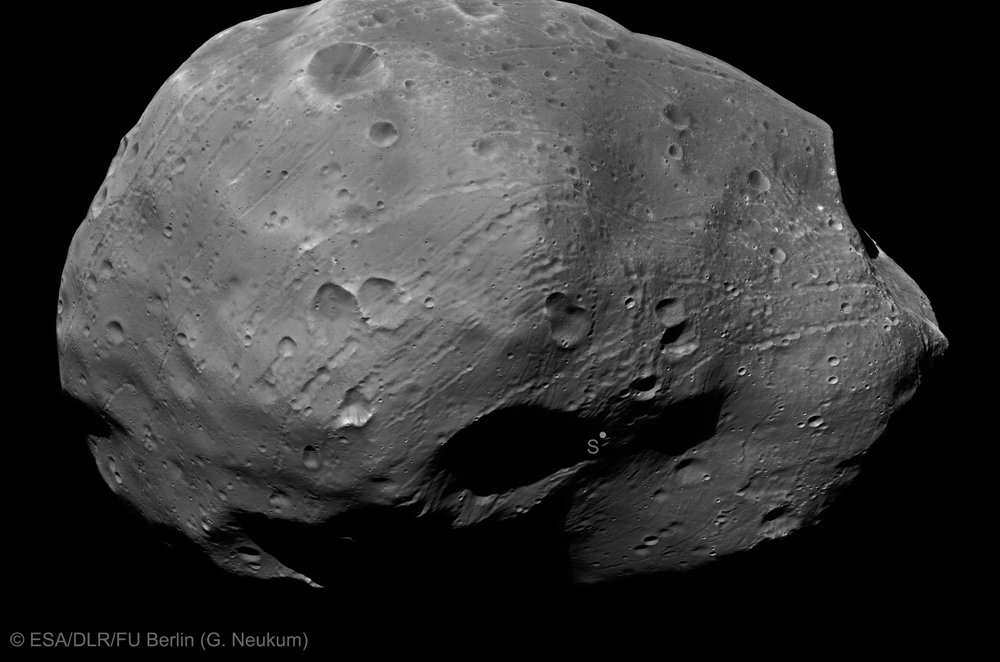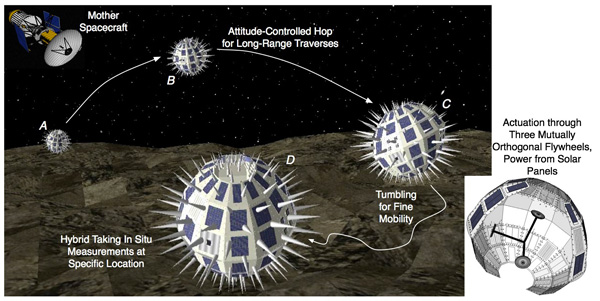NASA Eyes 'Hedgehog' Invasion of Mars Moon Phobos

A daring, "Angry Birds"-like NASA mission could bombard a Martian moon with robotic "hedgehog" probes in the next few decades, scientists say.
The space hedgehogs are actually small, spiky, spherical rovers that form part of a novel mission idea called Phobos Surveyor. The rovers would take advantage of the low gravity on the Mars moon Phobos, its sister moon Deimos, or asteroids in the solar system. Engineers have designed the devices to work in concert with a nearby mother ship.
The hedgehogs would work well in the low gravity of the 16-mile-wide (27 kilometers) Phobos, a force 1,000 times weaker than the gravity on Mars itself, where NASA's Curiosity and Opportunity rovers currently explore, said researcher Marco Pavone of Stanford University. Gravity on Mars is about one-third that of the Earth.
"The problem with [conventional] rovers is, in low gravity, you don't have any traction. That means your wheels spin and you do not move," said Pavone, who developed the hedgehog mission concept. [Boldest Mars Missions in History]
Robot hedgehogs in space
Instead of using wheels to move across a planetary surface, however, the hedgehogs would use internal, rotating discs. Plans call for three discs encased in each hedgehog. Each spacecraft would measure about 2 feet (0.6 meters) in diameter, and NASA has already built a prototype version, researchers said.
The three discs inside a hedgehog point in different directions, giving controllers the ability to move the devices with precision, Pavone said. Slightly speeding up the discs can send the hedgehogs tumbling, and a quick spin can make the hedgehog hop to a nearby location, he added.
Breaking space news, the latest updates on rocket launches, skywatching events and more!
To get to Phobos, the hedgehogs will potentially hitch a ride inside the proposed Phobos Surveyor, which could be a Discovery-class NASA mission with a cost of about $250 million and a streamlined development schedule to meet its science goals. At best, the Phobos mission could launch in 10 to 20 years, but that assumes the concept is approved and funded.
The exploitation of inertial motion is not entirely new to space exploration, as the Japanese Space Agency's Hayabusa spacecraft pursued a similar idea. That craft released a small lander while above the asteroid Itokawa.
Dubbed MINERVA (for MIcro/Nano Experimental Robot Vehicle for Asteroid), Hayabusa's tiny lander was supposed to bounce on the asteroid using rotating actuators. But it never made it to the surface.
NASA's hedgehog would have the ability to not only hop, but also tumble, which would make it potentially a more versatile lander than MINERVA if it were to arrive on Phobos, the research team said.
Separately, NASA's Jet Propulsion Laboratory has developed a nanorover concept, which envisions a rover that can both hop and roll. This device was planned for a space mission, but that mission never got off the ground.
Pavone's team has already built two versions of the hedgehogs, but the rovers still require several design changes before they could make it to space. The researchers also plan further testing, including flying the hedgehogs on parabola flights that simulate low gravity, just to see how they behave.
Pavone said he hopes the hedgehogs will help solve a long-standing mystery: Did Phobos form at the same time as Mars, or is it an asteroid pulled in by the Red Planet's gravity?
"By providing answers to this equation, it will be possible to calibrate this model ... for [other] asteroids through the solar system," Pavone said.
According to the plan, five or six hedgehogs could make the trip to Phobos, which would take about two years. The Phobos Surveyor mother ship could then spend a few months analyzing potential landing sites before releasing the hedgehogs, one at a time.
The mother ship would stay in orbit and map the surface's composition, though scientists are still discussing which actual instruments to send aboard the craft. The ship could also relay the hedgehogs' findings back to Earth.
The Phobos Surveyor study is funded under the NASA Innovative Advanced Concepts Program and includes contributors from NASA's Jet Propulsion Laboratory, the Massachusetts Institute of Technology and Stanford.
Follow Elizabeth Howell @howellspace or SPACE.com @Spacedotcom. We're also on Facebook and Google+.

Elizabeth Howell (she/her), Ph.D., was a staff writer in the spaceflight channel between 2022 and 2024 specializing in Canadian space news. She was contributing writer for Space.com for 10 years from 2012 to 2024. Elizabeth's reporting includes multiple exclusives with the White House, leading world coverage about a lost-and-found space tomato on the International Space Station, witnessing five human spaceflight launches on two continents, flying parabolic, working inside a spacesuit, and participating in a simulated Mars mission. Her latest book, "Why Am I Taller?" (ECW Press, 2022) is co-written with astronaut Dave Williams.


